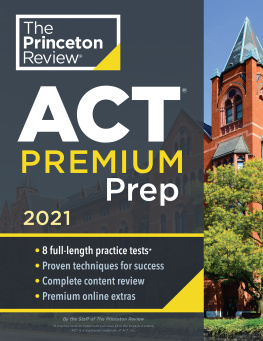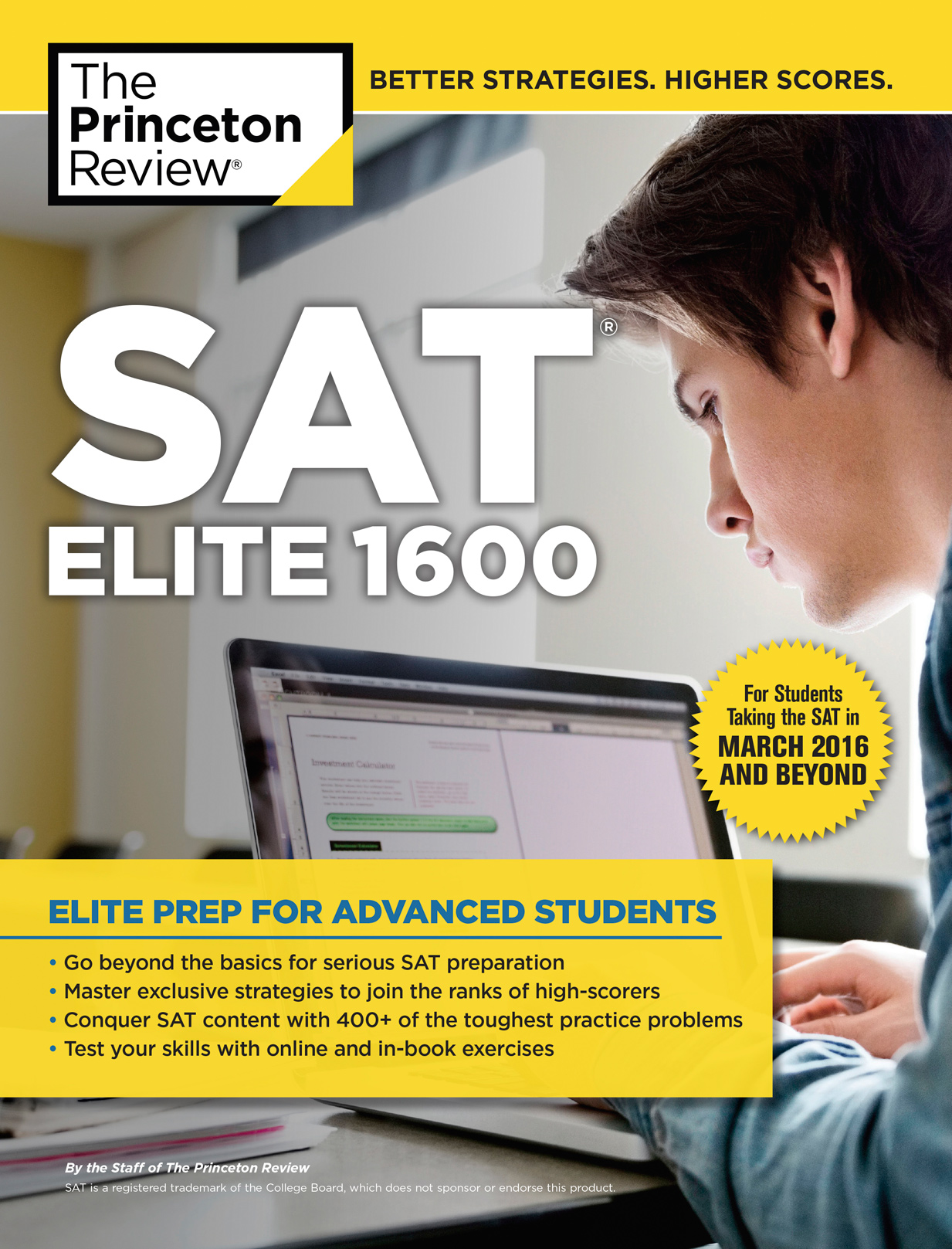Editorial
Rob Franek, Senior VP, Publisher
Casey Cornelius, VP Content Development
Mary Beth Garrick, Director of Production
Selena Coppock, Managing Editor
Meave Shelton, Senior Editor
Colleen Day, Editor
Sarah Litt, Editor
Aaron Riccio, Editor
Orion McBean, Editorial Assistant
Random House Publishing Team
Tom Russell, Publisher
Alison Stoltzfus, Publishing Manager
Melinda Ackell, Associate Managing Editor
Ellen Reed, Production Manager
Kristin Lindner, Production Supervisor
Andrea Lau, Designer
The Princeton Review
24 Prime Parkway, Suite 201
Natick, MA 01760
E-mail:
Copyright 2015 by TPR Education IP Holdings, LLC. All rights reserved.
Cover art Hero Images Inc. / Alamy Stock Photo.
Published in the United States by Penguin Random House LLC, New York, and in Canada by Random House of Canada, a division of Penguin Random House Ltd., Toronto.
Terms of Service: The Princeton Review Online Companion Tools (Student Tools) for retail books are available for only the two most recent editions of that book. Student Tools may be activated only twice per eligible book purchased for two consecutive 12-month periods, for a total of 24 months of access. Activation of Student Tools more than twice per book is in direct violation of these Terms of Service and may result in discontinuation of access to Student Tools Services.
eBook ISBN9781101882061
Trade Paperback ISBN9781101882016
SAT is a registered trademark of the College Board, which does not sponsor or endorse this product.
The Princeton Review is not affiliated with Princeton University.
Editor: Aaron Riccio
Production Editors: Beth Hanson and Liz Rutzel
Production Artist: Deborah A. Silvestrini
v4.1
a
Acknowledgments
Authors
Brian Becker
Kathryn Menafee
Amy Minster
Elizabeth Owens
Contributors
Aaron Lindh
Bobby Hood
Cat Healey
Anthony Krupp
Chris Knuth
V. Zoe Gannon
Project Managers
V. Zoe Gannon
Kathryn Menafee
National Content Director, High School Programs
Jonathan Chiu
Contents
Go to PrincetonReview.com/cracking
Youll see a welcome page where you can register your book using the following ISBN: 9781101882061
After placing this free order, youll either be asked to log in or to answer a few simple questions in order to set up a new Princeton Review account.
Finally, click on the Student Tools tab located at the top of the screen. It may take an hour or two for your registration to go through, but after that, youre good to go.
If you are experiencing book problems (potential content errors), please contact with the following information:
your full name
e-mail address used to register the book
full book title and ISBN
your computer OS (Mac or PC) and Internet browser (Firefox, Safari, Chrome, etc.)
description of technical issue
Once youve registered, you can
Access and print out online drills as well as the corresponding answers and explanations
Find any late-breaking information released about the SAT
Sort colleges by whatever youre looking for (such as Best Theater or Dorm), learn more about your top choices, and see how they all rank according to The Best 380 Colleges
Check to see if there have been any corrections or updates to this edition
Chapter 1
Introduction to the SAT
The pursuit of a perfect or near-perfect SAT score is an impressive goal. Achieving that goal requires a thorough command of the material and strategies specific to the SAT. To begin your quest, learn everything you can about the test. This chapter presents an overview of the SAT, advice about when to take it, and a guide to reporting your scores.
WELCOME
So you think you can score a 1450 or better? Were all for it. The Princeton Review supports all students who want to do their best. Weve written this book specifically for students who are in a position to score at the very highest levels. We believe that to achieve a perfect or near-perfect score, you have to know as much as possible about the test itself and, more importantly, know yourself.
You may know all of the basic facts about the SAT already, but even if you think you do, we encourage you to read through this chapter to be sure you know every single thing you can about the test youre going to conquer.
FUN FACTS ABOUT THE SAT
All of the content review and strategies we teach in the following lessons are based on the specific structure and format of the SAT. Before you can beat the test, you have to know how its built.
Structure
The SAT consists of three main sections: Reading, Writing & Language, and Math. The Math is broken into two sub-sections, the first of which must be completed without the use of a calculator.
There is also an optional essay section, for which you are given fifty minutes. This may seem like fewer sections than the previous SAT, but if you add it all up, youre looking at at least three hours of test-taking, and almost four if you complete the essay. Whew!
Scoring
The Reading and Writing sections are scored together on a scale from 200800, and added to the total from the two Math sections (also on a scale from 200800) for a total score between 400 to 1600. There are are also a series of sub-scores that point out how you did on specific types of questions, such as math problems that require data analysis or reading questions that focus on understanding words in context. All that really matters, however, is the overall score, which has a maximum of 1600.
Content
In , well thoroughly review the content and strategies you need for each of the three main sections. Here is a brief overview of each section.









